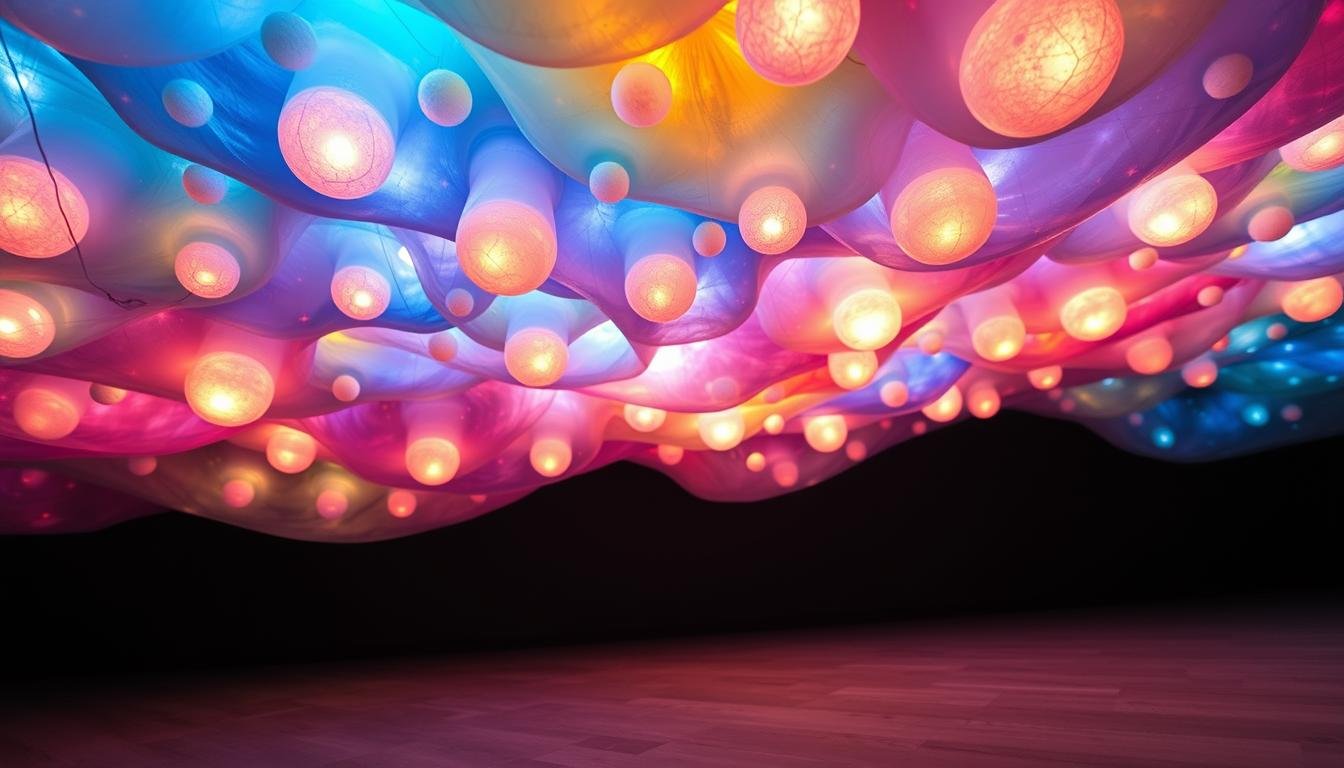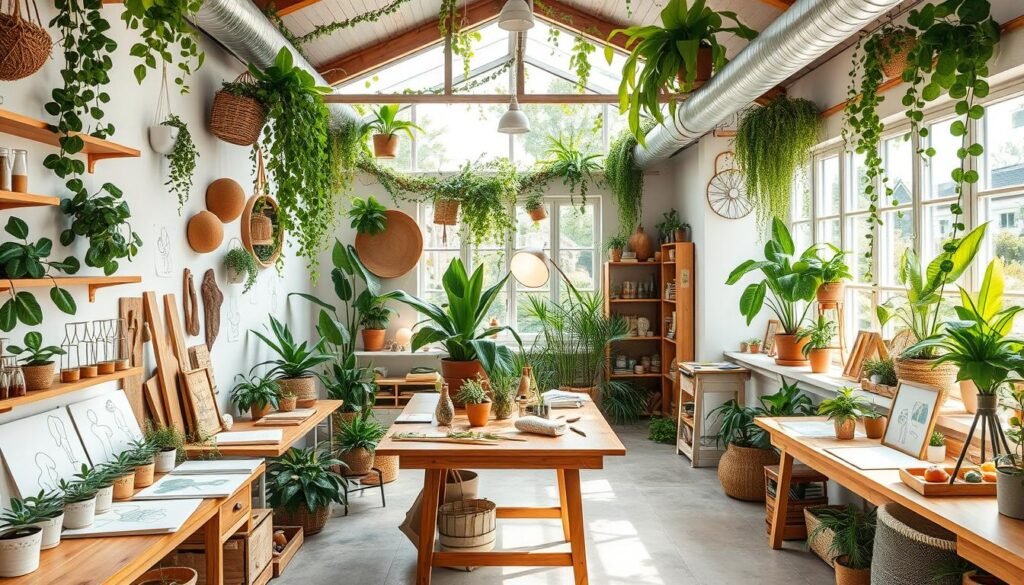

Design Chemistry breaks the norms of traditional education. It merges design creativity with scientific accuracy. This exciting blend leads to inventive solutions for everyday problems. For instance, students in a product design class used biology and chemistry to make the “Nebula Light”. This eco-friendly lamp uses anodized aluminum, bamboo, and recycled glass. It’s a perfect example of combining beauty with practicality, all while helping the environment.
Under Timothy Calhoun’s guidance at BioClean USA in Bridgeport, CT, students created a method to clean aluminum with bacteria. This process removes the need for harmful chemicals. Such a groundbreaking method proves Design Chemistry’s role in creating green solutions. By blending art and science, students not only invent great products. They also change how we think about science, design, and being eco-friendly.
Table of Contents
ToggleKey Takeaways
- Design Chemistry innovatively combines creativity and science.
- Real-world applications include eco-friendly products like the “Nebula Light.”
- Interdisciplinary design offers environmental and functional benefits.
- Important educational advances help accelerate student growth and inspire future careers1.
- Institutions like BioClean USA drive practical, sustainable solutions in Design Chemistry.
Discover the thrilling mix of design and chemistry. See how innovation, creativity, and teamwork lead to green progress.
Introduction to Design Chemistry
Design Chemistry combines the main parts of chemistry and biology with practical design tasks. This mix is changing the way we teach basic education. Now, students get involved in Interdisciplinary Design Education. They face *real-world design challenges* that relate to biology and chemistry.
Marci Klein, M.D., and Cofounder at 3DuxDesign, talks about the need for *design chemistry fundamentals* in schools. She believes this approach helps students work on environmental issues, offering a hands-on learning experience2. It makes students more excited about learning and helps them create lasting solutions by combining biology and chemistry.
These innovative solutions use multiple disciplines, preparing students for future career challenges. Schools using Interdisciplinary Design Education are creating future leaders ready to solve big environmental and societal problems.
Moreover, students benefit as they improve their critical thinking and creativity. They gain skills needed for success in many fields. This change in education is a forward step in addressing real-world biological and chemical challenges3.
Interdisciplinary Exploration in Design Chemistry
Mixing different fields like biology, chemistry, and engineering breaks down academic walls. This combo lets students creatively tackle environmental issues. It also boosts STEM learning.

Collaboration Between Subjects
Students get to explore at the intersection of subjects. For example, the “Travel Seminar: Greece” course merges history and science, focusing on Greece’s influence on modern design chemistry4. At Esopus Meadows Environmental Center, up to 64 students can dive into STEM projects together5.
Elective stations at Esopus Meadows, like Navigation and Water Chemistry, enrich the learning experience5. Such settings spark innovation by letting students put theory into practice.
Benefits for Students
Field trips in courses like cognitive ethology show the complexity of animal thinking up close6. This hands-on learning builds a strong STEM base. And highlights the value of combining disciplines.
This learning method also awakens environmental awareness. Courses studying history and economics, like “From Dutch Trading Post to Great Metropolis, 1624-1898,” offer 7 credits. They reveal how past decisions affect today’s design and environment4. Such courses prepare students to face today’s challenges effectively.
Working across disciplines, students learn to be innovative and think critically. These interdisciplinary programs pave the way for them to lead in solving future global issues.
Explore more about the innovative blend of design and science.
Hands-On Learning: Engaging Real-World Applications
Hands-on learning turns design chemistry ideas into exciting projects. This method is crucial for students to take part in experiments and research that address real problems. The beautiful Lake Placid and Adirondack Mountains near Northwood School make perfect settings for such studies. This kind of education uses great resources and covers subjects like geology and biology. It makes learning about design and science much richer7.
Experiential Learning
Northwood School has a special way of teaching design chemistry. It uses local things to make learning special for each student. The subjects are connected and teach kids to care about their community7. Plus, the Innovation Hub in Lake Placid adds to these learning chances. It offers tools and helps students connect with the community to improve their problem-solving7.
Research Projects and Innovations
Vassar College’s Field Work Program shows how hands-on learning can solve real problems. By graduation, 75% of students have done fieldwork or community service, and hundreds take part each semester. This program teaches them about environmental issues and the need to help others8. Northwood School also focuses on practical experiences in their teaching. This prepares students for future studies and careers in STEM and beyond7.
Working with groups like the NYSDEC Estuary Program and Hudson River Park adds extra learning chances. These partnerships let students explore topics like marine ecology and environmental justice. They improve their design and innovation skills. Through these activities, students learn more and find new ways to protect the environment9.
| Institution | Programs | Outcomes |
|---|---|---|
| Northwood School | Place-Based Education, Innovation Hub | Improved Problem-Solving Skills, Integrated Learning |
| Vassar College | Field Work Program | Real-World Problem-Solving, Social Responsibility |
| Collaborative Organizations | Marine Ecology, Environmental Justice | Design-Thinking, Innovation |
Environmental Consciousness in Design
Teaching the importance of environmental care in design chemistry is key. By looking at the past, like the Hudson River’s pollution from oil, PCBs, and more, we learn why eco-friendly making is crucial10. Also, seeing how cutting down trees affected the Hudson shows the need for green design10.
BioClean USA shows how industries can embrace sustainable design. They aim for eco-friendly methods and inspire students to think green. This shows the impact of thinking about our ecological mark on projects.

Laws made in 1965 changed things. They let people sue for environmental reasons and pushed companies to check their impact10. These steps are core to thinking and making in eco-friendly ways.
General Electric stopped using harmful PCBs because of new rules. The fight by Scenic Hudson in 1962 against a power plant shows how laws and advocacy support green efforts10.
This pushes students to design with the planet in mind. They learn from past wins and how working together can make a difference. They’re taught to lead in creating eco-friendly and innovative designs.
The Hudson River’s story over 200 years teaches a lot. Deforestation hurt many aspects, like water sources and leading to droughts11. Knowing this helps new designers embrace green and sustainable practices today.
Nurturing Future Innovators in Environmental Design
Teaching future innovators about environmental design is key. Programs in *Sustainable Design Education* and *Environmental Engineering* are shaping the future of eco-friendly design. BioClean USA, for example, guides students in creating sustainable products. It’s vital to emphasize education in fostering *Green Entrepreneurship* and innovation.
BioClean USA boasts a large 19,318 square foot space and can house up to 95 people12. Their system gives 30% more fresh air than the usual, making a healthier work space12. They also have over 15 Naava green walls improving air quality and worker health12.
Educating with real-world examples shows students the value of meeting WELL, LEED, and Living Building Challenge standards12. Hands-on experiences enhance their learning and push innovation in *Environmental Engineering*. Projects aim for high certifications like Living Building Challenge Petal, LEED v4, and WELL Platinum level12.
Organizations like *The World Around* offer the Young Climate Prize for under 25s focusing on climate justice13. They inspire by connecting architecture, ecological, and social justice at their summits13. Future designers learn to tackle global challenges and explore cross-discipline projects, promoting *Green Entrepreneurship*13.
Discover Hudson Valley Ride: Experience and Inspirations
The Discover Hudson Valley Ride offers a chance to see the region’s charm and beauty. Cyclists can pick from distances like 3, 10, 15, 30, 45, and 545 miles14. It’s perfect for both experienced riders and beginners, with scenic views that will last a lifetime.
This event takes riders through Hudson Valley’s vineyards, orchards, and hills14. You’ll see beautiful sights like the Wallkill Rail Trail, with its 300-foot cliffs15. Plus, the Walkway over the Hudson offers amazing views from 212 feet up15.
Tommy Struzzieri, from Alpha Win Racing, and Dr. Mike Halstead, an Ironman triathlon enthusiast, created this ride16. Their experience and passion for biking shine through in this outstanding Hudson Valley event16.
Every day of the ride brings new adventures. Cyclists start with 20 to 50 miles and end with 14 miles on Departure Day15. Highlights include a beautiful ride from the Catskills to the Hudson River and peaceful country routes15.
For those looking to join, the Discover Hudson Valley Ride has events in June 2024. This includes the Bike New York event on June 23, featuring scenic paths through vineyards and by the river14. The year also features events like the Ride for Roswell and the Tri-State Trek, supporting cancer and ALS research14.
The Discover Hudson Valley Ride is an inspiring way to explore a gorgeous part of the U.S. It’s a mix of challenge and natural beauty for cyclists and nature enthusiasts. Whether you’re riding for fun or a cause, it’s an event not to be missed.
Art Meets Science: The Role of Aesthetics in Engineering
The combination of art and science in engineering is changing our design view. It blends imagination with precision. This blend makes aesthetics key in today’s engineering.
Aesthetic Considerations in Modern Engineering
Today, aesthetics are essential in creating both useful and good-looking structures. An exhibit in Albany shows the importance of the Hudson River through history and environment. It shows how art can make technical projects stand out17.
By focusing on beauty and use, engineers make structures that deeply connect with people.
Engineers use artworks to inspire their work, like the ancient Chauvet cave paintings. These pictures show how early people mixed art and science. This mix leads to better designs, happier users, and greener ways18.
Innovative Materials for Artistic Expression
Using creative materials has opened new doors for engineers. Picking materials that are both strong and beautiful is important. For example, the materials in Michelangelo’s Sistine Chapel works show how new materials can create lasting art in buildings18.
This mix of art and science brings many benefits to engineering. It helps create buildings that help the environment and look amazing. This way, engineers make a big difference with their work19.
Sustainable Developments: Engineering and Art Collaboration
Art and engineering working together lead to green solutions that are both beautiful and kind to the planet. Sustainable engineering is key in Creative Sustainability. It solves real-world issues while keeping art and the environment in mind during design.
Creating Eco-friendly Solutions
The Brooklyn Grange, a top rooftop farming venture in the US, charges for farm tours. This highlights the value of sustainable city farming20. Also, the Center for Architecture offers free entry and has paid programs. They focus on green building and teaching sustainable methods20. These cases show how organizations can be eco-aware, reach people, and stay financially sound.
The Role of Creative Thinking in Sustainability
Combining art with engineering is crucial for sustainability. Basha Ruth Nelson’s ‘Beyond’ lets people see the Hudson River differently, mixing art and nature awareness21. Wilfredo Morel’s ‘Liquid Mechanics’ uses old pipes for art, showing how to repurpose materials creatively21. These works prove that artistic thinking helps in making green advancements.
Conclusion
Blending art and science has changed modern engineering. This mix joins creativity with science, starting a new phase in design. The Discover Hudson Valley Ride shows how beauty and green engineering blend22. Here, innovation meets real-world use, exciting new and expert riders alike.
By introducing different materials and tech, engineering’s artistic side is growing. Riders share their experiences with various bikes, like Teledyne and Colnago23. Their stories highlight both function and affection for different biking gear. They urge for gear that respects tradition and newness.
The future of design focuses on teaching eco-friendly innovation. It’s key to train thinkers who mix utility with creativity. With a strong push for green education and innovation, we’ll make designers ready to solve future challenges. This way, design stays fresh and considers the planet.
FAQ
What is Design Chemistry?
Design Chemistry mixes biology, chemistry, and engineering. It aims at finding smart, green solutions for real-world issues.
How does interdisciplinary exploration benefit students in design chemistry?
It encourages teamwork across different subjects. This lets students tackle environmental problems together. They enhance their creativity, problem-solving, and innovation skills.
What are the principles of sustainable design in the context of design chemistry?
These principles stress using eco-friendly materials and methods. They aim to cut down waste and think about the environmental impact of projects.
How does hands-on learning contribute to understanding design chemistry?
It makes the concepts of design chemistry real through active experience. Students apply their learning to tackle environmental challenges through projects and experiments.
What is the significance of environmental consciousness in design chemistry?
It’s key for teaching students to think about their designs’ ecological effects. This leads to more green innovations and less harm to the environment.
How does the Discover Hudson Valley Ride inspire design and creativity?
This ride takes cyclists through stunning areas. The beauty of nature encountered inspires creativity in their design work.
What role does aesthetics play in modern engineering according to design chemistry?
Today, engineers strive for a harmony of beauty and function. They use novel materials to create designs that look good and work well.
How do creative thinking and collaboration between art and engineering drive sustainability?
This blend fosters green solutions. By mixing art and engineering, sustainable and appealing designs emerge that are good for our planet.
What is the impact of interdisciplinary education on future designers and engineers?
It teaches them to think creatively and be eco-conscious. They learn to develop sustainable, functional, and attractive solutions.

As a trusted news source, Editorial Fox prides itself on upholding the highest standards of journalistic integrity. Our commitment to accuracy and fairness ensures that our readers can rely on us for reliable information.
Mail: info@editorialfox.com
About Editorial Fox
At Editorial Fox, we are committed to delivering high-quality journalism that informs and engages our readers. Our team of experienced journalists and editors work tirelessly to bring you the latest news and analysis from around the world.
Copyright @2024 Editorialfox.com All Right Reserve.


Be the first to leave a comment